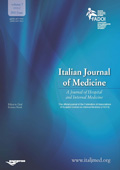Original Articles
20 March 2015
Vol. 9 No. 1 (2015)
Prevalence of neuropathic component of pain in a cohort of patients admitted to an Internal Medicine Department for chronic pain

Publisher's note
All claims expressed in this article are solely those of the authors and do not necessarily represent those of their affiliated organizations, or those of the publisher, the editors and the reviewers. Any product that may be evaluated in this article or claim that may be made by its manufacturer is not guaranteed or endorsed by the publisher.
All claims expressed in this article are solely those of the authors and do not necessarily represent those of their affiliated organizations, or those of the publisher, the editors and the reviewers. Any product that may be evaluated in this article or claim that may be made by its manufacturer is not guaranteed or endorsed by the publisher.
3393
Views
869
Downloads
1701
HTML






